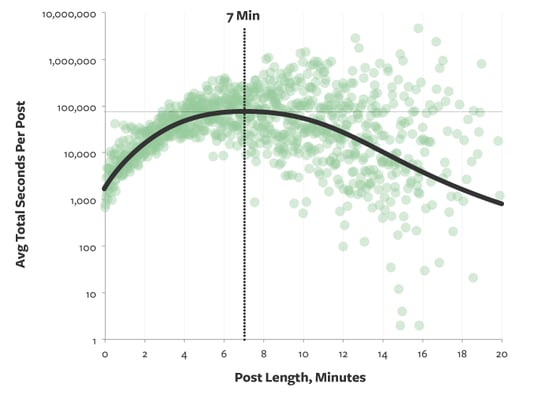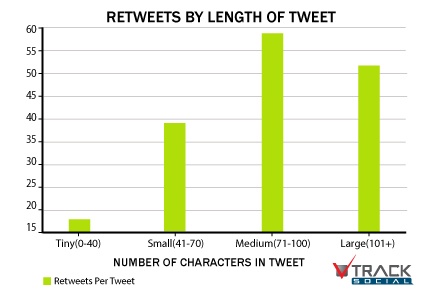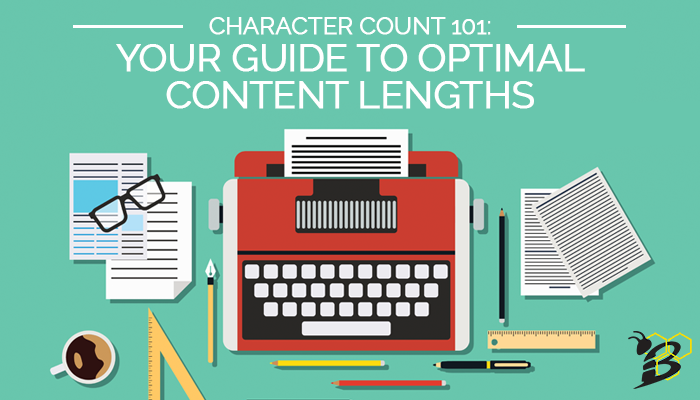Here at HIVE, we often have to field questions about the ideal character count for any given type of content. And this is a completely valid question. We all know that content is crucial for so many reasons but it can't do it's job unless your prospects are willing to consume it. And developing content that is a digestible length is an important component of ensuring it will be consumed. Now, I'll admit, there is not a one-size-fits-all solution for any type of content. A lot of it depends on your industry, the complexity of what you're offering and your audience. But there are some benchmarks that serve as great starting places for you to determine what will work best for you.
Let's dive right in:
1. Blogs
Blogs are possibly the most difficult type of content for which to determine optimal length merely because of the nature of ths content. Not all blog posts are created equal and not all industry's blogs will perform the same. Ultimately, you're probably going to have to do a little testing to determine what works best for your particular business and audience but we do have some recommendations for you to start with.
Headline
As Dustin taught us in his 5 Reasons Blogging for Business is a MUST post, search engines love blogs and strong and consistent blogging can really benefit your SEO results. To take full advantage of these SEO benefits, it's also important to craft a search-friendly headline. Try to keep the title under 70 characters so it doesn't get cut off in search engine results, and put keywords near the front to make it more attractive in search results. This will also help your users better understand the focus of the blog in their search results as they'll be able to read the entire title and notice their keyword making it more likely that they will click through.
You want your headline to look like this: 
Not like this: 
Meta Description
The meta description is almost as important in search engine results as the headline. A meta description is the HTML attribute that explains the contents of a given webpage. It's the short description you see on each search engine result to "preview" what the page is about. Like the headline, this is important to the user because a well-crafted result will give them a good idea of what the blog focuses on and help decide if they want to click through.
While Google doesn't actually cut off meta descriptions based on number of characters (they evaluate based on pixels), a well-crafted meta description should be no longer than 155 characters (which is about 923 pixels, Google's cut-off).
For example, let's pretend we searched for "ways to build credit." The result below is one that might come up. Notice the meta description right under the link in the result. This is a strong meta description because it has not been cut off by Google, includes the keyword and gives the user a realistic expectation of what they will read if they click through. 
Blog Post
Remember when I said that blogs are the most difficult content type to determine optimal length for? Well headlines and meta descriptions are the easy part. It's the actual body of the blog that starts to get complicated. And I don't think you're going to love my answer to this one. The optimal length for the copy of a blog post is however long it needs to be in order to get your point across or fully explore your topic. It's too difficult for us (or anyone else really) to give a single benchmark that applies to all topics and industries due mainly to the nature of blogs and the audience reading them. We can, however, give you some places to start with:
- Our partner, HubSpot recently analyzed the HubSpot Marketing Blog (a total of 6,192 blog posts) and found that blogs between 2,250 - 2,500 words had the highest organic traffic results and posts over 2,500 words received the most social shares and earned the most inbound links.

- Conversely, blogging platform Medium did their own analysis and found that the post length that captures the most attention on average were posts that took seven minutes to read (they measure based on how long it takes to read), which works out to be about 1,600 words.

Here at HIVE, we make sure never to post a blog shorter than 300-500 words. We've found that blogs under that length tend not to full explore the topic and don't engage the reader enough to be valuable to them so we like to use that as a starting place for both our internal posts and our clients posts. Overall, our clients vary so drastically in industry and overall strategic focus that we don't have a single benchmark that use use for all clients. Instead, we analyze each client on their own to determine optimal character count for that particular client.
That said, please, don't take any of these benchmarks as a solve-all for your blog. The best way you'll find to determine your business' personal optimal blog length is to post blogs of various lengths and do some testing of your own.
PRO TIP: If you do find that you need more words rather than less to explore your topic, do all your users a favor and break it up with some images like I've done here. Images make wordy posts easier to digest and give the reader additional assets to share socially should they choose.
2. Social Media
Social media is much more straight-forward than blogs when determining best character count in many ways merely because social media networks have maximum lengths for your content. Also, however, because regardless of industry type or topic, users tend to consume all social media posts in a similar way.
Twitter is by far the easiest social network to determine ideal character count for since their limit (140 characters) is so low. Some studies (including this one by Track Social) have indicated that tweets with 70-100 characters see the most retweets.

Other studies indicate that tweets under 100 characters see slightly (we're talking 17% higher) engagement rates. Given however, that the differences are so slight, we don't think that the difference between a 100 character and a 140 character tweet are significant enough to make a difference. So just stick with the 140 limit (which should be easy considering Twitter physically won't allow you to go over) and you should be good to go.
Facebook has a maximum status update limit of 63,206 characters. (I know, totally random number, right? If you're interested how they decided on this specific number, check out Bob Baldwin's reasoning in this Facebook post.) Even though Facebook says you can use that many characters, PLEASE do us all a favor and never ever use that many. Your reader would be totally overwhelmed and would, almost certainly, not consume that content.
But what is the ideal length for a status update? Experts seem to agree that the sweet spot is right at 40 characters. In fact, based on this Buffer study, posts with 40 characters receive 86% more engagement than posts with a higher character count.
The maximum length of a status update on LinkedIn is 600 characters. But most experts have indicated the best length actually comes down to words here, not characters. For B2B posts, 16-25 words perform best. For B2C posts, 21-25 words perform best.
EXPERT TIP: The above research only applies to LinkedIn posts. If you're publishing on LinkedIn Pulse, follow the metrics we outlined for blog posts. This platform works in a similar way.
Instagram and Pinterest
Instagram and Pinterest are a litte different than our other social networks due mainly to the fact that they are so much more visually driven than the other networks. So your image is actually much more important than your post copy. But we didn't want to leave them out even though there doesn't seem to be a strong correlation between success on either of these sites and copy length. Our recommendation is to keep the copy pretty short based solely on the fact that these are image-driven. We tend to stay under 150 characters so that users get the point quickly and don't have to expand the copy to read a lot of what we're trying to get across.
The only exception to this rule is hashtags. Instagram and Pinterest are driven by hashtags and lots of users tend to use these to find content. So go crazy with your hashtags. Just make sure they all actually relate to your post. For example, don't #MarchMadness if your image isn't something related to the NCAA Tournament.
3. Content Offerings
Much like blog posts (in fact, probably even more so than blog posts), your more robust content offerings: your ebooks, whitepapers, case studies, etc. do no necessarily have set length benchmarks. This is where you really want to stick to the "as long as it takes to get your point across" rule. But there's one other important thing to consider with these robust offers, make sure that the amount of content you're providing correlates well with the proposed value of the offer. If the content offer is something that your persona will value very high then they are more likely to consume longer content.
For example, let's pretend that you are a financial planning firm developing an ebook that outlines the importance of investing in your 20s. This content offering is going to be targeted towards a persona who should be investing in their 20s, but one of their biggest hang-ups is that they don't understand the benefits of early investing. This is a scenario in which a longer ebook that fully explains the benefits of investing early and where that can take you is valuable. Because your target persona has communicated their concern that they don't understand, they will likely be open and willing to consume a larger piece of content that will explain it to them.
CONCLUSION:
While these benchmarks are good places to start, please remember that there is no silver bullet or golden rule when it comes to content lengths (or marketing in general). The best possible way to determine what will work best for your business is to test, test, and test some more. Data is your best friend when it comes to finding out what works best for your business and what your customers are consuming.





.png?width=100&height=100&name=Why%20Were%20Not%20a%20Marketing%20Agency%20(And%20What%20That%20Means%20for%20Your%20Growth).png)
